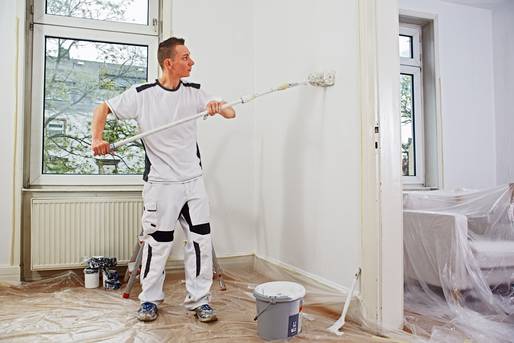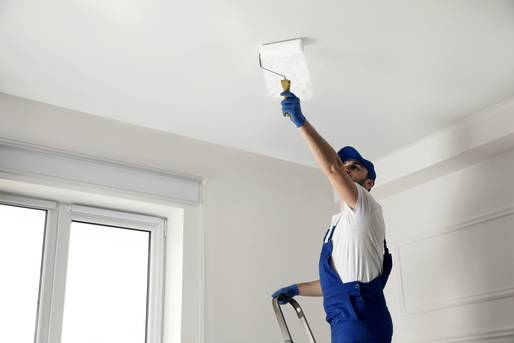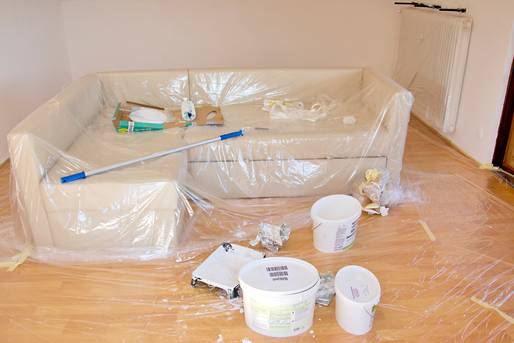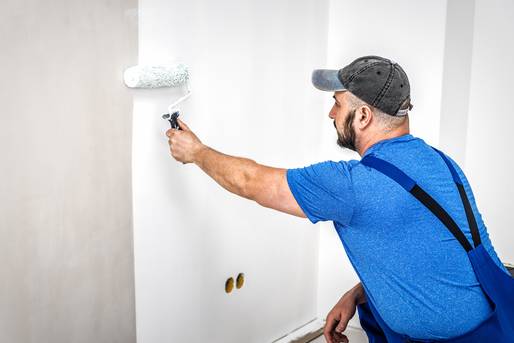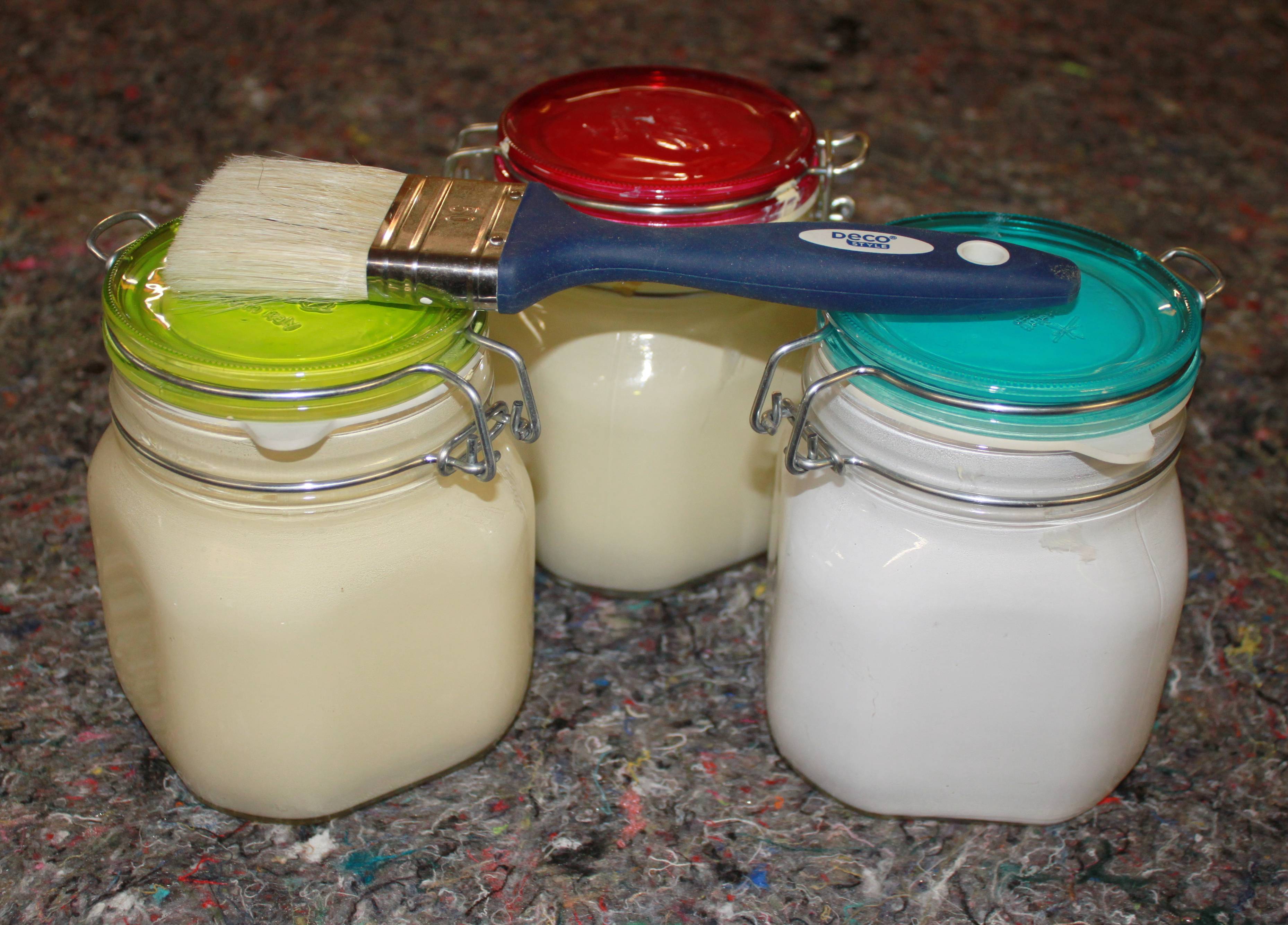Painting work during renovation » Tips for painting yourself
Published: 24.11.2023 | Reading Time: 6 minutes
This text is machine translated.
Painting work is the most frequently carried out renovation work. A new coat of paint is easy to apply even without extensive specialist knowledge. What counts for a good result is experience and a little skill.
However, professional renovation also requires the use of a suitable paint that covers well and is easy to apply. The specialist staff at your local store will be happy to help you choose the right paint and calculate the required quantity.
Once the masking materials, ceiling brushes and paint roller are ready, you can actually start painting.
However, there are still some important jobs to be done before the paint is applied to ensure that the end result of the renovation really is perfect. We will be happy to explain the best way to proceed with your painting work.
When planning painting work, the right time is extremely important. However, it is not about the exact time when the work takes place. Rather, it is about the perfect lighting conditions. Painting should preferably be carried out in daylight so that it is possible to see exactly where the paint has already been sufficiently applied.
If this is not possible, it is essential to ensure that the room is evenly lit in artificial light. Otherwise, unsightly streaks will become visible once the paint has dried. However, if you plan to apply two coats of paint during modernization, you can start in the evening and in artificial light. Once the paint has dried the next day, the final coat of wall design paint can be applied in daylight.
It is quite true that painting is the actual main task in painting work. However, a number of important activities are required beforehand in order to be able to work properly.
Create space
To create space for the renovation work, the furniture should be cleared out of the room or arranged in the middle of the room.
The furniture can then be covered with plastic sheeting, newspaper or wipes. The floor should be protected with plastic sheeting or painter's fleece.
Lampshades and other attachments in the painting area must be removed or neatly masked off.
Please also note our information on this topic in the guide to electrical work.
Preparing the wall or ceiling
To ensure that the results of the renovation work look perfect, wallpaper should only be painted over if it is still well bonded down to the last corner. Otherwise, be sure to remove the old wallpaper from the wall. Wallpaper residue and peeling paint can be easily removed from the wall with a scraper.
Damaged areas in the plaster and dowel holes that are no longer required can be plastered with plaster, fine plaster or acrylic (silicone cannot be painted over). Excess nails from pictures should be pulled out of the wall and not hammered in completely. Otherwise, unsightly rust spots may appear on the nail heads later on. Wash off dust and dirt with a sponge. The wall or ceiling must then be allowed to dry thoroughly
Glue on covers
Everything that is in the immediate vicinity of the painting surface but should not be painted must be covered. Painter's masking tape is recommended for light switches, sockets, window and door frames and skirting boards. The edges of other colored walls or surfaces must also be masked.
Our practical tip: Painter's masking tape
Always use masking tape or masking tape for masking. On the one hand, these adhesive tapes have a sufficiently strong adhesive effect to prevent the paint from running under the tape. On the other hand, painter's masking tape can also be easily removed without damaging the substrate.
Use protective clothing if required
Practical disposable clothing that is simply put on is suitable for protecting personal clothing. It is important that the disposable clothing is large enough to allow the necessary freedom of movement when working.
Primer
Not only untreated plasterboard in drywall construction requires a primer. If, for example, the plaster in an old building crumbles or sands as soon as you brush over it by hand, a suitable primer is absolutely essential. The same applies if water droplets are absorbed very quickly and the wall darkens immediately when sprayed with water. Pre-treatment with a deep penetrating primer, for example, strengthens the substrate structure and reduces absorbency. This later results in an evenly covering layer of paint.
Test color tone
It's easy to make mistakes when designing walls in color. While the desired shade may have looked really good on the small color chart, the color may suddenly look too strong, too dark or even completely different when applied to a large area. To avoid this, simply apply a small test area with the paint roller and compare the result with the color on the card.
First, use an angled radiator brush to work on all corners and edges that cannot be reached with the roller. Then use the paint roller to cover the entire wall.
Short-pile paint rollers are suitable for smooth surfaces and a fluffy long-pile roller is used for rough surfaces.
Apply sufficient paint to the paint roller that has been moistened with water beforehand. Excess paint is removed at the scraper grid. This prevents the paint from splashing when rolling.
Work wet on wet. This involves applying the wet paint from the paint roller partially over the wet paint on the wall. This results in a seamless transition. Also, do not try to roll the paint roller dry. The first coat of paint should be applied vertically and then the surface should be rolled horizontally again. This ensures an even coat of paint.
Once the paint application is complete, check that the paint is applied evenly over the entire surface. If necessary, imperfections in the still wet paint can be easily repaired.
Removing masking tape
It is important to remove the masking tape at the right moment, especially for sharp-edged transitions. If the tape is removed too soon after painting, the wet paint may run. If the tape is removed too late, the already dried paint will create an unclean cracked edge.
Storing leftover paint correctly
The bucket with the leftover paint must be sealed airtight. If necessary, small paint residues can be stored airtight in preserving jars. The storage location for opened paint containers should be dark, dry and frost-proof.
Clean tools thoroughly
It goes without saying that brushes and paint rollers must be cleaned thoroughly after work. Otherwise the tools will become unusable over time due to the dried paint. However, if a second coat of paint is planned for the next day, it is perfectly practical to store the used paint roller overnight in an airtight plastic bag. When renovating facades, experts also like to store the used paint roller overnight in a paint bucket filled with water to prevent the paint in the roller from drying out.
Do not forget to ventilate
After painting, the room should be well ventilated. Ideally, the indoor and outdoor temperatures should be approximately the same. If it is significantly warmer or colder outside, the window should remain closed while painting. In order to transport the humidity produced when the paint dries to the outside, use shock ventilation. To do this, open doors and windows regularly to ensure the necessary draught. If the outside temperature is low, the room should also be heated.
Do not prepare the substrate
If a substrate with different levels of absorbency is not pre-treated, streaks may appear when the paint dries.
Wrong choice of paint
In addition to the shade and opacity of the paint, the type of paint (emulsion paint, silicate paint or latex paint) and the gloss level also play an important role in the renovation. The paint for radiators in the house must have different qualities than a paint for tiles, for example. However, the specialist advice in the specialist store will be happy to help here.
The wrong adhesive tape
Choosing the right masking tape is crucial. The adhesive strength must not be too weak, but also not too strong.
Do not paint edges cleanly
Edges and corners must be pre-painted cleanly with a brush. Experts refer to this as trimming edges. An angled brush and a small paint roller should be used for this.
Uneven paint application
Thoroughly wet the paint roller with paint and roll it out one strip at a time. Work wet on wet and move the roller by no more than half a lane. Then roll crosswise to achieve an even application of paint. Roll large areas quickly and do not take long breaks in between.
Not covering, covering insufficiently or covering incorrectly
It is more than annoying when the new floor or good furniture is covered in paint splashes after renovation work. Furniture and furnishings can easily be covered with foil or newspaper. The materials are only suitable for the floor if the area is not walked on. The floor in the work area should be protected with painter's fleece from the roll.
Do not remove paint drips immediately
Fresh drops of paint can often be removed easily, quickly and without leaving any residue. Once they have dried, however, they can become a problem. Especially if they have fallen onto sensitive surfaces that have not been adequately covered.
